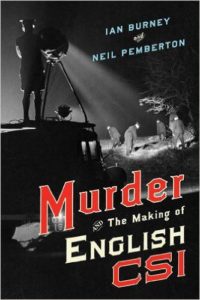
This book was reviewed for the Manhattan and Seattle Book Reviews
Burney & Pemberton’s Murder and the Making of English CSI looks at the birth and development of crime scene investigating through the lens of a single sociocultural point- England. This field of study, in its broadest sense, has fascinated me for nearly three decades. Were it not for a medical malady stealing my sight, I would have continued pursuing a career in forensic anthropology. Needless to say, I loved the book.
Broken into several chapters, it focuses on the growth of CSI within the confines of that most heinous of crimes, where the skills are most critical- homicide. For simplicity’s sake, the authors note that the initials of ‘CSI’ are used, even at times when it might be anachronistic because there was no cohesive discipline as such at the time. At no point did I find this to be confusing.
The first chapter looks at origins of scene investigation in general, particularly within Hans Gross’ 1893 Crime Scene Investigation: A Practical Handbook. I found it intriguing that even this far back, Gross recognised and emphasised the utmost value of trace evidence. Also looked at were the contributions of Edmond Locard, he of the transference principle, to this burgeoning discipline. I love that one of his inspirations was Doyle’s immortal Sherlock Holmes!
The second chapter takes a look at what crime scene processing, or the lack thereof, was like in context of England. Discussed are Howard Vincent’s Police Code and Manual of Criminal Law, first published in 1881 and Alfred Swaine Taylor’s Principles and Practises of Medical Jurisprudence, first published in 1865. Early English focus was on body evidence rather than trace evidence. It wasn’t until the early to mid 20th century that Gross’ Handbook was translated and the principles implemented.
Chapter Three focuses on a hallmark case of English CSI growth, that being the 1924 murder of Emily Kaye. The fourth chapter looks at how this particular case was sensationalised and became fodder for new storytelling, from detective magazine puzzles, to new stories, to screen portrayal.
Chapter Five covers how the transition of body to trace oriented evidence progressed and meshed within English criminalistics, and teaching these first waves of detectives how to process for trace. Chapter Six further continues this discussion and looks at forensic pathology. Chapter Seven and Eight look at Rillington place, where several bodies were found. A good example of synergy between body and trace evidence.
I really enjoyed this book, and the history discussed. If you have a more than casual interest in forensics, this is a must have for your personal library. Why a ‘more that casual’, you might ask? This book is college textbook worthy. If one isn’t used to that, it may come across as dense writing. Prospective readers should also be prepared for the graphic crime scene photos scattered throughout.
????? High recommended.

